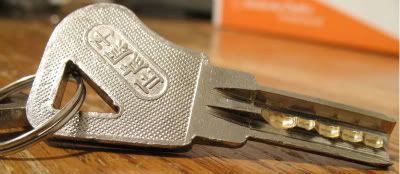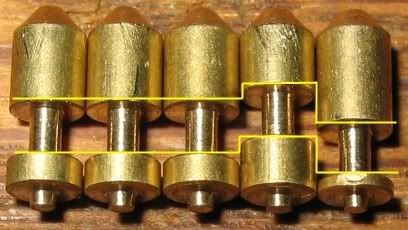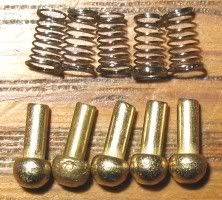Boy am I late on this.
Well a few days ago I finally brought the drill out to separate the shell from the plug.
Good job on picking it Jimmie!
I tried and failed miserably.
Even my smallest pick (half diamond which I'm terrible with) can barely maneuver in that small keyway.
What kind of pick did you use?
I can't really tell from the picture.
Any tips?
This lock is pretty neat.
I'll share what I've learned about it so far.
Here are the main components of the lock.

The first thing I noticed when I got this lock was the key.

I had never seen one like it and I was very curious.
At this point I'm thinking maybe the lock is just a regular pin tumbler but with an odd keyway.
But once I got the shell+cylinder out of the lock I realized there were two sets of pins, perpendicular to each other.
Also, these pins were not the ordinary pins I'm accustomed to seeing.

Let's look at the key pins:

So these are like regular key pins but with some extra stuff attached.
There are two important facts to realize here:
1) The pins are all the same length (when I say pin here, I mean the entire object, not just the key pin).
2) The size of the gap between the bottom of the key pin and the attached "pin" is the same on all pins. However, the placement of this gap varies due to varying key pin sizes.

Now for the other pins which I'll call side pins.

These are all exactly the same, like regular driver pins.
You may notice something about these springs.
They have a larger diameter on one end for the "ball" point.
I don't know if they come like that or if it's just wear and tear.
Just for fun, here's the key pin springs (left) next to the side pin springs.

Anyways, you've probably already figured out how this lock works.
But just in case:
When you depress a key pin you are moving the gap between the top and bottom portions of the pin.
The correct key will depress the pin to the point where its gap aligns perfectly with the side pins' hole.
This would then allow a side pin to slide into that gap.
When all the side pins can slide into their gaps, the plug can turn.
When you try to rotate the plug, you are trying to force the side pins into their gaps.
The ball part of the side pins rests on a slope.
One really cool thing about this plug is that you can pick it with your bare fingers!
Just depress a key pin all the way and then try to press the side pin for it.
Keep pressing in the side pin (with slight pressure) and slowly let the key pin up.
At some point the side pin will will slide into position and the key pin will not move anymore.
Be careful when doing this though because when you let go of the side pin, the key pin will probably fly away.
Plus these springs are super springy.
I shot a video real quick that sort of demonstrates the whole "gap" thing:
http://video.google.com/videoplay?docid=-1712856425888871369&hl=en


















